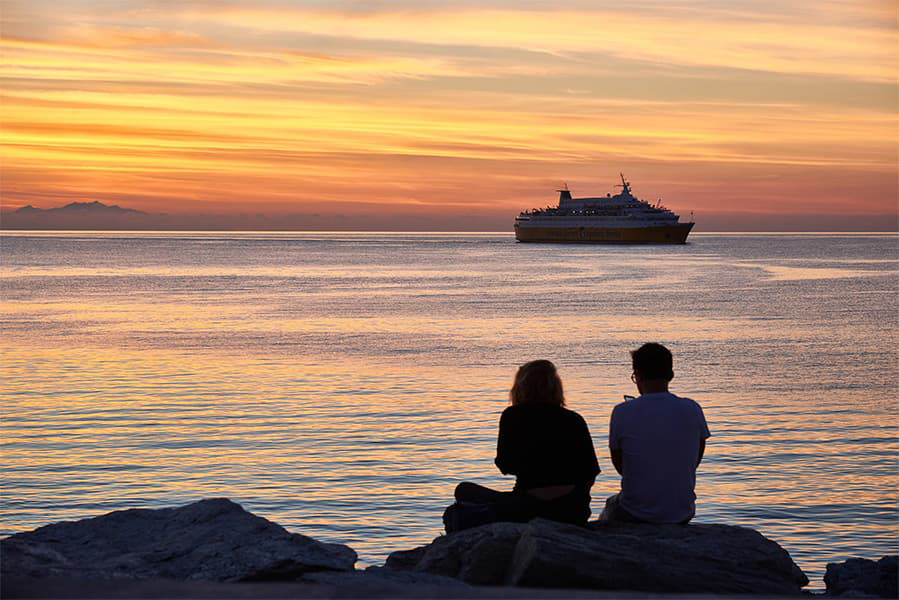Ronne - Sassnitz
Ferry to Germany
Ronne - Sassnitz
Ferry to Germany

Depending on the season their are about 4 weekly sailings between Ronne and Sassnitz.Bornholmslinjen provides the ferry from Ronne to Sassnitz. Ronne Sassnitz ferries take around 3 hours 20 minutes. The ferry costs between $248 and $1475, depending on ticket details. Prices exclude any service fees. Ferry timetables change seasonally, use our Deal Finder to get live pricing and availability for ferries from Ronne to Sassnitz.
The earliest Ronne Sassnitz ferry typically departs Ronne at about 08:00 and the last ferry usually leaves at 10:00.
Ferries from Ronne to Sassnitz sail in around 3 hours 20 minutes. Ferry duration can vary by ferry provider and can be impacted by weather conditions.
There is 4 weekly sailings from Ronne to Sassnitz provided by Bornholmslinjen. Timetables can change from season to season.
The price of a ferry from Ronne to Sassnitz typically range between $248* and $1475*. On average the Ronne Sassnitz ferry is $1,460.82*. The cheapest Ronne Sassnitz ferry prices start from $248*. The average price for a foot passenger is $225*. The average price for a car is $1467*.
Pricing will vary depending on number of passengers, vehicle type, route and sailing times. Pricing is taken from searches over last 30 days and exclusive of service fees, last updated 1 December 2025.
The distance between Ronne to Sassnitz is approximately 87 miles (139km) or 75 nautical miles.
Yes, Ronne Sassnitz ferries allow cars onboard with Bornholmslinjen between Ronne and Sassnitz. To view car ferry tickets and prices between Ronne and Sassnitz use our Deal Finder.
Bornholmslinjen allow foot passengers on Ronne Sassnitz ferries.
Currently, are not permitted to board ferries from Ronne to Sassnitz.
More routes than anyone else.

Compare fares, times & routes in one place.
Change plans easily with flexi tickets.

Book e-tickets & manage trips in-app.
Live ship tracking & real-time updates.

Top-rated customer support when you need it.
| Ronne - Sassnitz Ferry Route summary | ||
|---|---|---|
| Departure Destination | Bornholm | |
| Destination | Germany | |
| No. of Operators | 1 | |
| Operators | Bornholmslinjen | |
| Average Price | $1461 | |
| Average Daily Sailings | 1 | |
| Average Weekly Sailings | 4 | |
| Average Sailing Duration | 3 h 20 m | |
| Fastest Sailing Duration | 3 h 20 m | |
| First Ferry | 08:00 | |
| Last Ferry | 10:00 | |
| Distance | 75 Nautical Miles | |
* Prices subject to change, pricing is taken from last 30 days, last updated 1 December 2025.
The Danish town of Ronne is located on the island of Bornholm which lies in the Baltic Sea. The small island, measuring around 29 sq. km, has around 11,500 residents and a natural harbour. Because of its harbour, and as a result of its Baltic Sea location, the town's history has been influenced by both the Germans and Swedish since the town was founded as a herring fishing port. Today, it is a popular visitor destination with most visitors coming from Denmark, Germany, Poland and Sweden. Visitors enjoy wandering around the town's cobbled streets, visiting the museums and taking in the splendid half-timbered houses. There are two streets in the town that are of particular importance. Laksegade and Storegade both have many historic houses which were once home to the town's noblemen and merchants. Also of interest in the town include the Defence Museum, the Bornholm Museum, the Smedegards rising school, ST Nicolas' Church and the 19th century lighthouse.
ferries from the town's harbour connect Ronne to the rest of Denmark and also to Koge, Ystad, Sassnitz and Swinoujscie. Fast catamarans also operate to Ystad which provide onward rail connections to Copenhagen.
The island of Rugen protrudes into the Baltic Sea, and its largest town, Sassnitz, is a popular tourist destination and its harbour, which stretches around 1.5 km out to sea, is a magnet for luxury yachts, fishing boats, passenger ferries and pleasure boats. The old part of the town is located to the north east of the harbour and just past the harbour, near to a disused ferry terminal, is a U-boat museum that has amongst its exhibits a British submarine, the HMS Otus, which was rescued from a scrapyard in Portsmouth and towed to the museum. All in all the island has over 40 museums to offer its visitors that cover a range of subjects from local history to underwater archaeology. Also of interest to visitors are a number of churches, palaces and stately homes, including the Ralswiek Palace and the Granitz hunting lodge which dates back to the 19th century.
As a result of its good connections and its geographical proximity to Scandinavia, Russia and the Baltic States, the Port of Sassnitz is an important hub for international passenger and goods traffic.